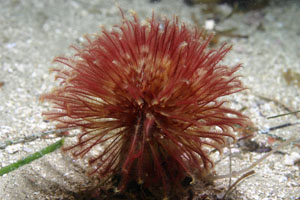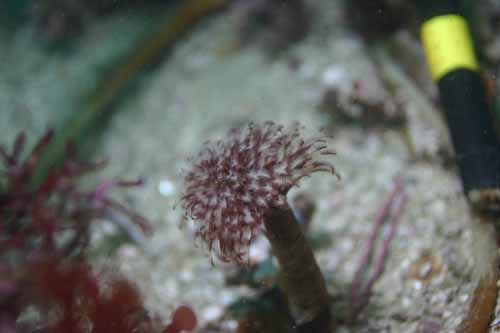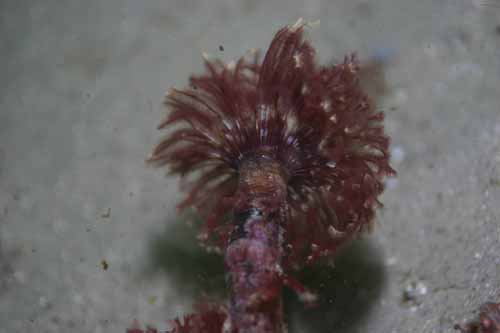
Vancouver feather duster worm
Eudistylia vancouveri
Overview
Key Features:
Large reddish plume with banding. Plume retracts very quickly, and a firm, rubbery tube becomes visible. The closely related Eudistylia polymorpha has a plume with only one color and no banding, which easily differentiates the two species. In central California, usually in sand and solitary.Similar Species:
Feather duster worm (Eudistylia polymorpha)Primary Common Name:
Vancouver feather duster wormSynonymous name(s):
Eudistylia plumosa, Sabella vancouveriGeneral Grouping:
WormsGeographic Range:
Alaska to central California
Occurs from Alaska to central California, but is more common in northern part of range relatively rare in central CAIntertidal Height:
-2 to 0 feet (-0.6006006 to 0 meters)Subtidal Depth Range:
Minimum Depth: 0 meters or 0 feetMaximum Depth: 30 meters or 99.9 feet
Notes:
Found in the shallow subtidal.Habitats:
bay (rocky shore), exposed rocky shore, kelp forest, protected rocky shoreNotes:
In the northern part of its range, often found on pilings and floats in harbors, and may be seen draped off pilings at low tide.Abundance:
Relative Abundance:
Uncommon in central California.Species Description:
General:
The obvious feature of this polychaete worm is the large branchial plume, which is a cluster of elongate tentacles that serve as both gills and feeding structure. The tentacles have a banded color pattern, with light but narrow bands on a usually dark red background. The tube is made of protein and has a rubber-like consistency, firm after the worm quickly retracts the plume.Distinctive Features:
Large plume that quickly retracts if disturbed. Tentacles are 1-4 cm long and highly branched along a main axis. In central California, the large plume of tentacles is banded. The parchment tube is firm and dark brown when not overgrown.Size:
Body up to 25 cm long, although usually only a few cm of the tube is visible. Plume diameter can be 6 cm.Natural History:
General:
The large plume of Eudistylia serves two functions: respiration and feeding. The tentacles are covered with hundreds of cilia that generate a tiny, localized current. Water and suspended particles are swept into the tentacles where they are captured in mucus and then conveyed along the main axis of the tentacle towards the mouth.The tentacles also bear small, light-sensitive structures that react to changes in light. Shadows and pressure waves cause the worm to rapidly retract the tentacles into the protective cover of the tube. This rapid withdrawal reduces predation on the vulnerable tentacles. The tube extends will into the back of crevices and the entire worm is rarely ever observed.
Predator(s):
Fishes may attempt to bite the plume tentacles. It is not known which species prey upon feather duster worms. However, if the entire worm is exposed, as when rocks are dislodged during storms, they may be scavenged by crabs, fishes, stars, and carnivorous snails.Prey:
Feather duster worms feed on suspended particles, including detritus and plankton.Feeding Behavior:
Omnivore, Sessile suspension feederNotes:
The worm uses cilia to move water through the plume of tentacles, ensnaring particles with both the cilia and with mucus that is secreted. The slime with trapped particles then moves down the tentacle to the mouth, with some sorting taking place.Seasonal Behavior
January - December
Reproduction:
We do not know of any seasonal behavior in reproduction or feeding.Issues
Monterey Bay National Marine Sanctuary:
We do not know of any.References
- Lamb, A. and B. P. Hanby. 2005. Marine life of the Pacific Northwest. Harbour Publishing. 398 p.
Related Information
Photo Library
Click on an image below to view a larger version in the SIMoN Photo Library. You will also be able to view important information on each photo such as photographer, date, caption and more

